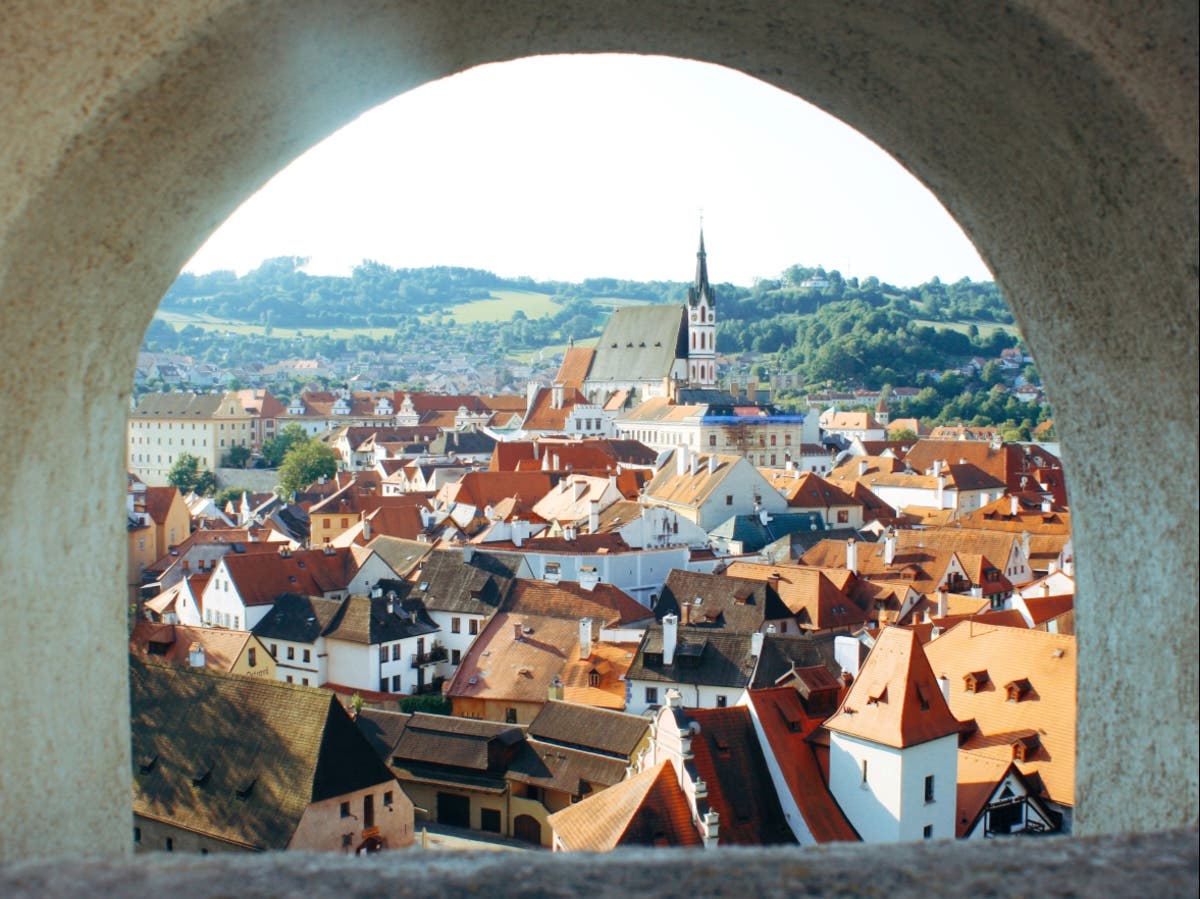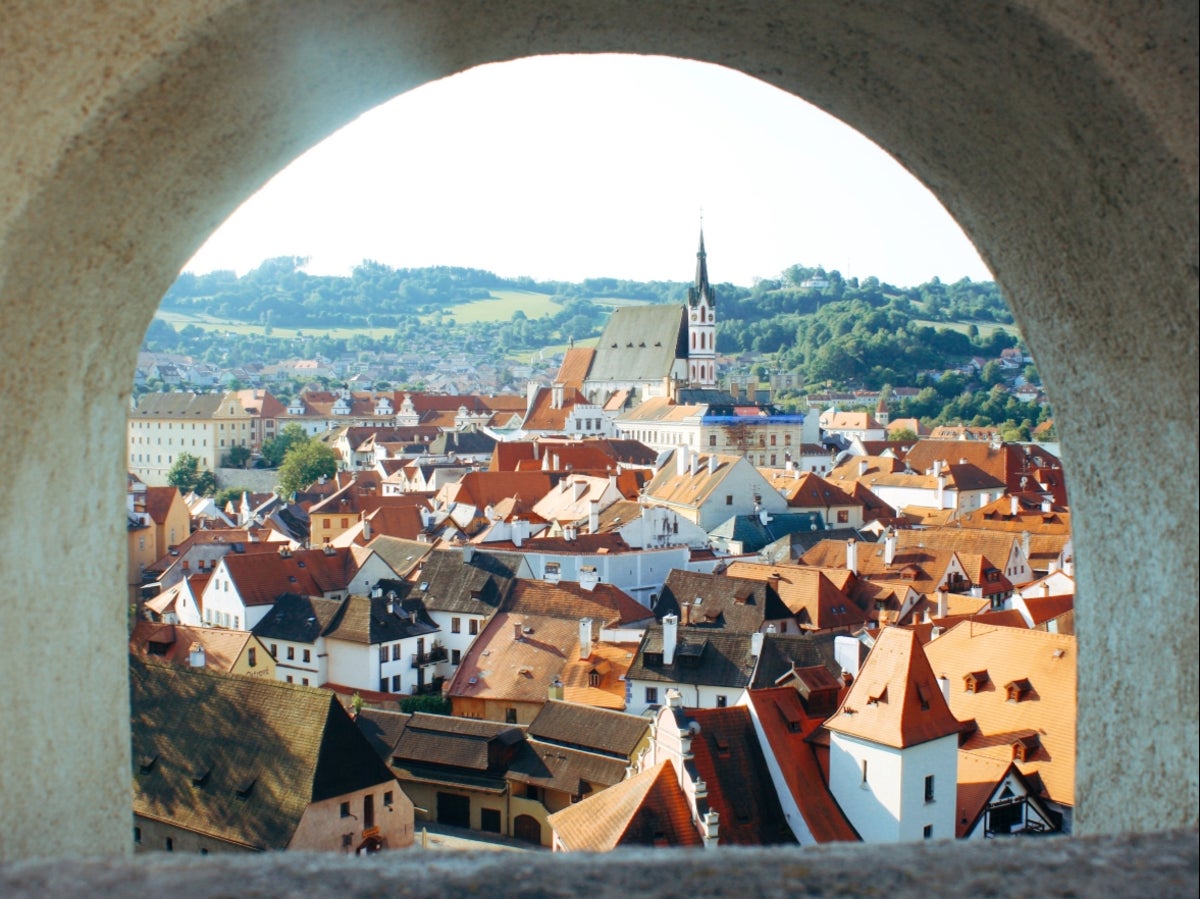“The name ‘Vltava’ comes from the old Germanic for ‘wild water’,” says tour guide Michal Pavlík, as he punts us along a languid meander in the river that carves through the Czech town of Český Krumlov, around 110 miles south of Prague.
“As you can see, it’s very wild,” he adds, nodding towards a family of ducks gliding past. It’s then I realise I’m not only sitting alongside a skilled timber rafter but also an aficionado of another prized national pastime: deadpan joke delivery. I settle in for the ride.
As school parties and couples wobble about in canoes, I’m glad to be perched on a little bench atop a sturdy wooden craft, with time to survey the Gothic steeples and Renaissance facades that jostle above the craggy riverbanks. Not that timber rafting has always been the easy option.
Making a splash while timber rafting
(Voroplavba)
From the 11th century up until the arrival of the railways, the Vltava was the main route for transporting timber from the deep Bohemian forests to booming Prague. People spent the winter felling and then stripping towering trees by hand. Come spring, these mighty columns were hauled to the river before being bound together with twigs and withe (flexible branches used for tying and binding) while currents bobbed and cajoled.
“The boats were a maximum of six metres wide because they had to fit through the narrowest rapids,” says Michal. “But they could be 200 metres long.”
It took teams of rafters nearly a week to complete the treacherous, sometimes deadly journey in these trailing vessels; on many stretches, the Vltava earned its ancient name. Selling the timber was well paid, although Michal points out the transaction’s downside: “It was a long walk home.”
Read more on Czech Republic travel:
To fully induct me into the cultural heritage of this recently Unesco-listed mode of transport, we pitch up next to a pistachio-green pub, where a server passes down glasses of frothy Budvar beer produced in the nearby national brewery in České Budějovice.
Then we’re off. Michal deftly pilots us down a stone weir, ending with a mini log-flume-style splash. I’ve also shown some sailing prowess: not a drop of beer lost.
I ask Michal if the Unesco listing has been good for the rafting business. “Of course,” he says, though he knows such recognition comes with risks too. He talks of Hallstatt across the Austrian border, where locals have resorted to obstructing lakeside views with fences in a bid to control spiralling tourist numbers: “They think maybe without Unesco’s mark, not so many people would come.”
Concerns about overtourism are relatable to residents here. Unesco hailed Český Krumlov as an “outstanding example of a small central European medieval town” in 1992 and listed it as a World Heritage Site. It’s now often described as “Prague in miniature”, garnering popularity with large coach tours that whizz around as many as seven European Unesco sites in 10 days.
Balancing Budvar beer while rafting in Český Krumlov
(Jenny Elliott)
Over dinner, I chat with English teacher Petra Lewis about the pros and cons of her hometown featuring on the tourist trail. She’s one of the volunteers who help run Prádelna, a multi-functional cultural hub within an old laundry building; it reopened in its current form in 2021, following a revamp.
She knows this space is precious; like in many destinations, over the last decade or so the arrival of Airbnbs and international brands has raised rents and squeezed many locals out of the town centre. She also describes a “fast” tourism which had started to overwhelm the town in the years immediately before the Covid-19 pandemic. “Big tour groups would walk from one side to the other in half an hour,” she says. “They’d think they’d seen it all.”
But Petra is also aware of how tourism – when done right – can help bring about positive change.
Our dinner venue – Krumlov Mill – is a case in point. In 1998, local Marek Šimon bought the 700-year-old former flour mill, rescuing it from decades of communist-era neglect. Stage by stage, he used profits from tourism to bring the handsome building back to life; the mill now houses a Czech restaurant and three stylish self-catering apartments. And although the old waterwheel on the exterior makes for pretty photographs, inside is the real deal.
The community makes this space. But also, by working here together, this space makes the community
After dinner, Marek shows how he has installed two modern water turbines to harness the power of the Vltava as it flows through the building’s basement. The eco-friendly turbines not only make the building self-sufficient but contribute to the town’s energy supply.
Marek is enthusiastic about the tangible benefits tourism brings. But, like Petra, he hopes the pandemic may have resulted in a shift; he’s keen for visitors to slow down and get to know the town: “It would be good if people stayed two or three days.”
Keen to embrace this more sustainable, unhurried travel, I’m following this suggested length of stay. Although, as I set out towards the free-to-enter castle grounds the following day, I feel wary. Český Krumlov’s medieval fortress has a fairy-tale quality that Disneyland marketing teams can only dream of, and its Renaissance pastel-tinted tower acts as a particular beacon for visitors. I’m expecting to have to photobomb my way through.
Yet I find myself almost alone, chasing distant figures through a series of silent passageways and sgraffito courtyards before reaching leafy gardens and panoramic views of terracotta rooftops. Perhaps I’ve been lucky. By late morning, day trippers start to appear, so I skip the castle tour and slip back into town for coffee.
A vintage portrait of Jenny captured at Museum Fotoatelier Seidel
(Lenka Štěpánková )
“You need to have a certain mindset to leave the main street,” says Petra Hanáková, explaining why her espresso bar Masná 130 retains a laidback community feel despite being moments from the town’s main thoroughfare. In 2015, she quit her role as a university lecturer in Prague, returning to her hometown to renovate a tumbling-down late Gothic house built into Český Krumlov’s ancient fortifications.
“The idea was it should be a place I would like to come,” she says. Masná 130 now serves ethically sourced coffee and homemade cake “like your grandmother would bake” to a mix of tourists and residents. Petra is keen to provide a reason for locals to return to the historic centre, and she uses the café’s position on a pedestrianised cobbled street to run alfresco concerts featuring local bands.
“The town needs to be alive,” she says. “Otherwise, it would be like a theme park. And you don’t want to live in a theme park.”
Over the next couple of days, I discover you don’t need to scratch very far below the picture-postcard veneer to find a strong, creative pulse.
The town needs to be alive. Otherwise, it would be like a theme park. And you don’t want to live in a theme park
I walk through the pretty town park to Museum Fotoatelier Seidel, a time capsule Art Nouveau mansion once home to pioneering photographers Josef and František Seidel. Their archive captures the families and communities living in and around the Czech-German-Austrian borderland from the late 19th century, through the Nazi occupation and much of the communist era. I study the faces for tells of tumultuous lives behind the camera-ready smiles.
Photographer and guide Lenka Štěpánková asks if I’d like my own vintage-style portrait. As I wriggle into a heavy skirt and sash, she tells me how the museum gives her and other young local creatives and curators a chance to follow their passion without leaving their home town. “We think this museum is like a parallel of Český Krumlov,” says Lenka. “There’s nowhere else quite like it in Europe.”
Later, I’m similarly smitten with the Egon Schiele Art Centrum, a brewery turned gallery named after the Austrian painter and protégé of Gustav Klimt. Seeing Schiele’s paintings of the town makes me curious to see the cherry-red studio where, in 1911, he lived with Wally Neuzil, one of Klimt’s life models. It’s now a tiny museum and cafe.
By the time I meet hospitality specialist and guide Eduard Ondracek at Bistro Naplavka (a riverside container bar serving vegan hotdogs and local beer that I’d clocked while rafting with Michal), I realise three days wasn’t long enough. He points me toward a glut of creative restaurants using seasonal local produce. He also suggests I stop by Apotheka café bar and Zapa bar – the “A-Z of Český Krumlov’s nightlife.” I start making notes for a return trip.
(Jenny Elliott)
I have one place I’m determined to visit this time around, though. On my last day, I meet Petra Lewis again to see an exhibition by Czech artist Petr Kubeš at the community hub Prádelna.
Inside is a beautiful mishmash of artworks, mid-century armchairs, pot plants, old hotel rugs and repurposed kitchen cupboards fashioned into a bar. “Everything here was given to us by locals,” Petra explains. “Even little children came and helped scrape the walls.”
She tells me that when bands play, they get a good mix of residents and curious, passing tourists. The event programme – just like the interior – is curated collaboratively by the volunteers. And although the graffiti-daubed exterior may, at first glance, feel at odds with the town’s more pristine facades, in many ways, Prádelna sits at Český Krumlov’s heart: a space shaped by craftspeople and artists, embracing both tradition and innovation.
“The community makes this space,” says Petra. “But also, by working here together, this space makes the community.”
Community hub Prádelna was created by locals
(Jenny Elliott)
Travel essentials
Getting there
Trying to fly less?
Take the train from London to Zurich (via the Eurostar to Paris). The 9.40pm sleeper train from Zurich arrives in České Budějovice by 9am the following day. If time allows, explore this handsome town, or at least stop for coffee and kolache (a disc-shaped Czech pastry) at Kmen Coffee Roasters opposite the station. Local train services run regularly to Český Krumlov from here, taking around 50 minutes.
Fine with flying?
Ryanair, Wizz Air, easyJet and British Airways all fly direct from the UK to Prague. The one daily direct train from Prague’s central station takes around 2.5 hours. Indirect trains (change at České Budějovice) take about 3 hours. Alternatively, travel to Český Krumlov by coach from Prague or Vienna in around 2.5-3.5 hours.
Staying there
Monastery Garden Bistro & Rooms is a locally owned boutique hotel. Seasonal a la carte breakfast is served in the eat-in kitchen, where you’ll find glasses of free filtered water and an honesty bar.
Rooms available from{{#price}}{{price}}per night{{/price}}{{^price}}Check availability for dates and prices{{/price}}
{{#amenities}}
Hotel Amenities
- {{#amenities.foodDrink.length}}
-
- {{#amenities.foodDrink}}
- {{.}}
{{/amenities.foodDrink}}
-
Internet
Please check hotel for more information on amenities- {{#amenities.internet}}
- {{.}}
{{/amenities.internet}}
-
- {{#amenities.services}}
- {{.}}
{{/amenities.services}}
-
Parking
Please check hotel for more information on amenities- {{#amenities.parking}}
- {{.}}
{{/amenities.parking}}
-
- {{#amenities.health}}
- {{.}}
{{/amenities.health}}
{{/amenities.foodDrink.length}}{{#amenities.internet.length}}
{{/amenities.internet.length}}{{#amenities.services.length}}
{{/amenities.services.length}}{{#amenities.parking.length}}
{{/amenities.parking.length}}{{#amenities.health.length}}
{{/amenities.health.length}}
{{/amenities}}
Krumlov Mill luxury apartments feature a sauna and hot tub, while units have their own fully equipped kitchens, 400 metres from Castle Český Krumlov.
Rooms available from{{#price}}{{price}}per night{{/price}}{{^price}}Check availability for dates and prices{{/price}}
{{#amenities}}
Hotel Amenities
- {{#amenities.foodDrink.length}}
-
- {{#amenities.foodDrink}}
- {{.}}
{{/amenities.foodDrink}}
-
Internet
Please check hotel for more information on amenities- {{#amenities.internet}}
- {{.}}
{{/amenities.internet}}
-
- {{#amenities.services}}
- {{.}}
{{/amenities.services}}
-
Parking
Please check hotel for more information on amenities- {{#amenities.parking}}
- {{.}}
{{/amenities.parking}}
-
- {{#amenities.health}}
- {{.}}
{{/amenities.health}}
{{/amenities.foodDrink.length}}{{#amenities.internet.length}}
{{/amenities.internet.length}}{{#amenities.services.length}}
{{/amenities.services.length}}{{#amenities.parking.length}}
{{/amenities.parking.length}}{{#amenities.health.length}}
{{/amenities.health.length}}
{{/amenities}}
Read more of our best Europe hotel reviews







More Stories
Everything you need to know about July and August rail industrial action
‘It’s cancerous’: How seaside towns fight back against second home owners
EasyJet flight diverted after passenger medical emergency on board